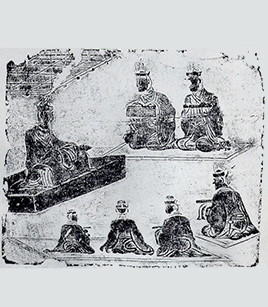Classics scholarship

FILE PHOTO: This rubbing of a Han Dynasty (206 BCE–220 CE) stone relief depicts a scholar lecturing on the Confucian canon.
Jingxue, or classics scholarship, originally referred to Chinese scholarship before imperial unification by the Qin Dynasty in 221 BCE. China saw a golden age of philosophy during the Spring and Autumn Period (770–476 BCE) and the Warring States Period (475–221 BCE), known as the Hundred Schools of Thought. It was the result of a broad range of thoughts and ideas being developed and discussed freely throughout this long period of time.
During the Western Han Dynasty (206 BCE–8 CE), Emperor Wu of Han (156–87 BCE) adopted the principles of Confucianism as the state philosophy and code of ethics, and instituted the study of Confucian canon as a state mandate. Since then, jingxue referred specifically to the study of Confucian classics, particularly the Six Classics (Liu Jing)—Classic of Poetry, Book of Documents, Book of Rites, Book of Change, Classic of Music, and Spring and Autumn Annals. The Six Classics were pre-Qin writings and were believed to be re-collected and edited by Confucius, who thereby fixed the versions which became the classics (jing).
The ancient Chinese believed that the classics included the fundamental principles for explaining the order of the universe, politics, ethics, and even daily life. Therefore, studying the classics became the most important academic activity starting from the Western Han Dynasty. Jingxue encompassed annotations and exegeses of classics, explications of the principles of classics, and discussions of such subjects as textual inheritance and traditions, as well as the origins of various schools of thought. Classics scholarship is pursued to express one’s fundamental understanding of the order and values of the world through constant exploration of the underlying implications of the classics.
Classics scholarship formed the main body of ancient Chinese academics. It contributed to the core of the traditional Confucian canon. Among the Siku Quanshu, the largest collection of books in Chinese history compiled in the 18th century, the Confucian section contains 1,773 books—a total of 20,427 volumes.
